Konn Lavery's Blog: Posts from konnlavery.com, page 58
November 20, 2015
Finished Your Manuscript, Now What?
NaNoWriMo is at the end of the third week, giving one final full week to reach the 50,000 word mark. As of today, you are now able to validate your word count to see if you if you have hit the goal. The exciting part about finishing NaNoWriMo is deciding what to do next, after spending hours each day working on your manuscript you suddenly find yourself with a ton of spare time on your hands.
First Take a Break and Make Notes Where You Left Off
You have earned it. Give yourself a break from the constant writing and let your brain destress from the pressure of reaching a word count goal every day. Before you do that though, leave comments about where you left off and where you were heading so you know what to do when you come back to write.
Explore Different Activities
An important part of writing that can easily be overlooked is remembering to take time away from the actual writing. Doing something different will provide new perspectives that you may have not previously had. Why not do some physical activities (exercising/sports) or pick up another art form like a musical instrument?
Talk to People Again
Start socializing! After all, writing tends to be a very isolated experience and interacting with people (friends, family or meeting new people) doesn’t happen as often as it does with other artistic avenues. We get wrapped up in the writing that it is easy to forget there is a world beyond the page. Go outside and talk to people, you’ll have lots to share about writing and you can learn new things from those around you. Who knows, it might inspire ideas for your next story.
Return to Your Manuscript
Now these are all ideas to get away from writing, just don’t stray too far away from it! Stepping away from writing can make it difficult to pick it up again. Give yourself a break but be sure to return once you have given your mind a chance to freshen up so you can approach it with a new viewpoint. Pick up where you left off to revise the plot and finish the story.
Remember to always plan ahead with writing, taking a break doesn’t mean you’re done. Pick a date to return to writing, think of it as a vacation.
The Greek Philosopher Aristotle Once Said:
“We are what we repeatedly do. Excellence, then, is not an act, but a habit.”
 Image from Wikipedia
Image from Wikipedia
For my own direction, now that I have finished NaNoWriMo, I will be putting The Unfortunate Tale of #YEGman away so I can return to the editing Seed Me for its release next year.
November 12, 2015
25,000 Words Reached!
NaNoWriMo is in the second week and I have hit the 25,000 word mark! That is half way to the 50,000 goal for the end of the month. It has kept me busy (among the graphic design and web work and trying to maintain something called a social life) meaning this blog post is more so of an update that I am still alive and working heavily at writing the manuscript for a story titled The Unfortunate Tale of #YEGman. This one is a thriller and has proven to be a challenge to write. Much like last year’s Seed Me story, I am exploring new writing directions from my comfort zone which is forcing me to think beyond my regular writing routine. Below is the working novel Synopsis:
In the darkest night streets of Edmonton, criminals and drugs are at every corner. The mayor and the chief of police are being pushed to their mental and physical limits. The people are fearful for their own lives. Edmonton is in dire need of some practical justice. Someone needs to give the felons and low lives what they deserve. Skip the courts and bring them justice in a first full of fury!
At least that is what Michael Bradford believes. That mentality is probably what got him kicked off the police force. For a year he has had to watch as his former partner and comrades of the law attempt to shut down the city’s most violent gang to date – the Crystal Moths.
Michael can’t leave the city he knows and loves to go down the sewer. It was time to take law into his own hands. As he transitions into a vigilante existence, Edmonton spawns its first serial killer since the eighties. Michael – the unknown hero to the public is dubbed as #YEGman – struggles to bring down the Crystal Moths organization and how they link to the mysterious killer. All of this while dodging being caught by the cops and keeping his violent nature at bay.
Once this month is finished, the first draft for the story will be complete and I will return to it and revise the storyline much like what I am doing for Seed Me. The Unfortunate Tale of #YEGman won’t be released this year or the next due to the other two books in the work, Mental Damnation IV and Seed Me that are projected for 2016 and 2017.
The objective to partake in this year’s NaNoWriMo is to get a working first draft that I can return to and revise when I am ready. So do not sweat, more Mental Damnation will be coming down the pipeline and Seed Me is still estimated to be released mid next year.
Cover photo Explanation: Dinosaur with a mustache – support for Movember. 25,000 words, slam dunk!
November 5, 2015
Interview with Horror Author Matthew Gillies
Matthew Gillies and I first met at the Edmonton Comic Expo as mentioned in a previous blog post, where we had connected through a mutual passion of writing, horror and graphic design. Matthew was willing to spend some time with me and discuss his own writing interests and experiences.
Currently I have two of Matthew’s novels, his debut novel The Electric Coma Dream (horror) and Oblivious Paradise (Sci-Fi). I am currently reading Oblivious Paradise and within the first 80 pages I have been roped into kidnapping, shredded flesh and cannibalism. Awesome! With an intro like that, who needs sleep? Without further ado, let me introduce the guest of the blog, Matthew Gillies.
Matthew, tell us a bit about yourself and your writing.
How I like to describe myself is: my name isn’t synonymous with horror. Not in the way that Edgar Allan Poe is known as the father of horror, H.P.Lovecraft as the godfather of weird, Stephen King as the master of the supernatural and Clive Barker as the anarchic prince of horror, but one thing is true… I am horrors’ newest disciple.
There is a reason I like to call myself the newest disciple. Horror fiction can be a large genre which encompasses a multitude of subgenres, such as Splatterpunk, Gothic Horror, Supernatural and so on. I prefer to call myself a disciple because I am not redefining horror. I am not looking to reinvent the wheel. I am simply a follower of the philosophy that makes up horror.
Myself in general, I’ve dedicated myself to professional writing for the last fifteen years – having written a number of manuscripts, published two short stories, four novels, with two more slated for release in 2016 and 2017. So I’ve been at it for quite some time now.
Give us an introduction to your debut novel The Electric Coma Dream.
The Electric Coma Dream is a surreal psychological horror novel about a young woman who slips into a coma after overdosing on heroin, only to emerge inside her desecrated mind. It is there, where she encounters the personifications of her inner-self and has to come to terms with her life; past, present and future.
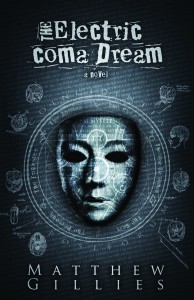 Mathew’s debut novel, The Electric Coma Dream
Mathew’s debut novel, The Electric Coma Dream
Who is your favourite character in this story and why?
My personal favourite would have to be Anastasia, the protagonist of the novel. The reason for it is when I wrote Anastasia, she acted as a kind of trauma sponge for me. She allowed me to channel all the emotions I felt through her – the feelings of alienation, self-destructive tendencies and the search for an identity.
Anastasia acted in a sense as a conduit to express those feelings that seemed so hard to understand. She was a character that experienced so much hardship… so much emotional confusion that she became a character that was relatable… someone to who could tell any reader that they were not alone in how they feel.
The other reason I enjoy her so much, is throughout the novel you see her develop from a timid naïve girl to a confident woman trying to get her life in order and no matter how much suffering she endures, she does not give up.
Is this your first manuscript/story written?
The Electric Coma Dream is actually the third novel I ever wrote. The first being a novel called The Experiment (formerly known as Psychotica). The Experiment was written 15 years ago and it was because of this novel that I came up with The Electric Coma Dream.
I was really fascinated with the Kafkaesque device of a character finding themselves in a strange and peculiar situation with no explanation as to why they got there and because of that, The Experiment was about a young man who finds himself inside a psychiatric hospital with no memory of why he was there – but during his time in the facility, he slips in and out of reality, where one second he is bound in a straight-jacket and left in a rubber room, and then the next, he’s in this dark fantasy world being stalked by hideous creatures.
Your first novel does fall under the horror genre, is this your favourite genre to write?
The horror genre is by far my favourite genre. It is so liberating to write horror because anything can happen in it. Severed heads can sprout legs and tentacles and crawl across your bed, and all you need to do to make it convincing is create a well-thought out mythology for the creature. And even if you don’t do that, it makes the story even more terrifying because no one knows what the hell that severed head is or what it is doing and that is the most frightening thing.
But yes, The Electric Coma Dream is a novel that falls into the horror genre… but in a different sense of horror. While a lot of horror novels want to write about monsters and tackle issues with gore and blood, The Electric Coma Dream handles horror differently. It examines the psychological nature of a character (Anastasia) who is losing control of her life chapter by chapter and does not know how to stop the rollercoaster of psychological torment.
How do you tackle clichés?
Clichés are almost unavoidable, not just with horror but with any kind of fiction writing. They’ve become the trope in which the foundation of formulaic writing is based upon and I do everything in my power to avoid clichés – particularly in dialogue and actions. If I start writing something that makes me cringe because it seems like it’s been done before, I challenge myself to write something completely different.
The problem is, sometimes when it comes to plot, it’s unavoidable. For instance, when I first wrote Oblivious Paradise, I wrote it as a sequel to my second novel ever written (The Pig Factory), which both dealt with a deadly virus that wipes out humanity. When I first wrote those two novels, the post-apocalyptic plot device wasn’t as popular as it is now.
Then suddenly, there was this influx of post-apocalyptic novels – especially within the YA genre. But instead of viewing this a negative thing, it tells me there is a market for the type of novels I’ve written, which don’t necessarily follow the typical format of commercial fiction. In fact, I’ve seen that with how popular The Electric Coma Dream has become.
Do you find there are challenges to overcome with writing horror that is different than other genres?
There are always challenges with writing any genre. For me, horror can become a challenge if you try to write something you expect people to expect. I think there’s an expectation that when someone writes a horror novel that it has to have some kind of supernatural evil or excessive gore to give it that kind of moniker.
For The Electric Coma Dream, it has its moment of excessive violence, but it doesn’t rely on the shock factor to make it horror. Rather I’ve written the horror to be psychological and to be as subtle as possible – it’s the slow-burn of horror that I use. Instead of bringing everything into the open all at once, I build up to the horror. For instance, throughout the novel, I make references to a wolf that stalks Anastasia in the shadows. In another section of the book, she develops a fear of her abusive ex-lover stalking her or the manipulative betrayal of someone she once considered a friend.
The other thing I’ve learnt with writing horror is that less is more. I’m in the process of writing three new horror novels – one about a the sudden disappearance of a town and another called The Dark, about a series of child kidnappings which one of the protagonists believes in the work of the bogeyman and a third called Dumpster Princess, about a young, bullied girl who befriends a grotesque monster. In working on all three of those novels, I’ve really reduced myself from giving away too much detail and really focused on creating an atmosphere of the unknown.
Do you have any methods you use inspire yourself to write creepy literature?
For me, it’s a factor of things. Writing is something that you have to jump into, whether you’re in the mood to write or not. Myself personally, I like writing late at night. I remember with my earlier novels – particularly The Experiment and The Electric Coma Dream, I would be up until three in the morning writing them. But the best thing for me to write was music.
Whether I am writing horror or science fiction, I always find music helps the process. When writing horror, I like listening to dark, often heavier music with a very gothic tone to it. Sometimes, depending on the scene I am writing, I may switch to something more melancholic and softer in sound. Music is probably the best tool for writing because it can really help a writer develop a sound to their own story.
Oblivious Paradise is more Sci-Fi/Cyber Punk, why the change in direction?
It started after I had written The Experiment. I was doing a lot of research on the book market and how to find a publisher or an agent, and the more I read, the more it seemed like Horror was one of those genres that wasn’t well-respected. At least at the time, I found a lot of agents/publishers were looking for commercial fiction – legal thrillers, police procedural thrillers, political thrillers – it really seemed like thrillers were a more dominate genre.
Even as a kid, I remember going to my local library and the horror section was like slim-pickings. But thrillers, I would see that sticker on the spin of so many books. Even now, when I go to bookstores, the horror section is primarily dominated by Dean Koontz, Stephen King, and Anne Rice. There are a lot of novels about vampires and werewolves and zombies, but very little of anything that extends beyond the supernatural.
It was disappointing to see this lack of love for the genre and I remember picking up a couple of books, reading the synopsis and thinking to myself, are these the same books? Because the synopsis was so similar. It had something to do with some emotionally stunted or damaged police detective investigating a murder and assigned a partner of the opposite sex (talk about clichés).
So while I was doing this research, one of things I noticed was that there was a huge market for science fiction novels. I thought, what the hell, if I can’t succeed at writing horror, maybe I’ll try my hand at science fiction. That’s when I wrote The Pig Factory – a novel about a survivor of a deadly pandemic who finds himself in some kind of quarantined building where mysterious figures wearing NBC Suits perform strange experiments on him.
It was only after I had written that novel that I came up with the novel Oblivious Paradise – a kind of standalone sequel that dealt with the effects of post-pandemic some sixty years later.
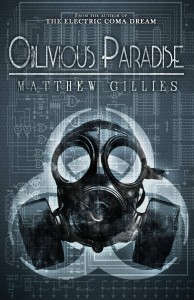 Mathew’s Sci-Fi Novel, a standalone sequel to a previous book he wrote.
Mathew’s Sci-Fi Novel, a standalone sequel to a previous book he wrote.
Is there other interests you have beyond writing?
I’ve always been a huge fan of art. Before I decided that writing was my passion, I dreamt of being a comic book artist. I would spend a lot of my time drawing characters and then as I was drawing the characters, I would create these stories for them… give them backstories and develop these long story arcs.
Eventually, I found it extremely difficult for me to draw. I was having a hard time translating what I saw in my mind onto the paper – so I started writing out what I saw… then I started creating the stories.
I still design, but now I do it through mixed-media design. I dabble in photo manipulations and design 3D characters to use for digital paintings and book covers.
Are there any influences or people you look up to for perusing writing?
I have quite a few influences but for me, most importantly are authors like Clive Barker, Neil Gaiman, H.P. Lovecraft, William Gibson and Chuck Palahniuk. Those writers have been a huge influence on me because their novels always took me to a fantastical world or presented me with great narrative.
Likewise! Clive Barker is a major inspiration for me. Thank you for your time to answer these questions to the readers! Any final comments about writing?
Read lots. Write lots. Don’t worry about whether people like what you’ve written or not. When I first sat down to write my first manuscript, it was because I wanted to write something I wanted to read. So for anyone serious about creating a writing career – don’t worry about what other people want to read… write what you want to read and you may be surprised by the fact that people are interested in that novel. I know I was after I released The Electric Coma Dream.
Thank you again Matthew for spending the time to discuss a bit about you and your writing. It was an enjoyable time to get to know your writing better. I look forward to finishing your novel and seeing what else you’ll conspire.
Cheers!
If you haven’t, you can check out Matthew’s work, you can find it on Amazon. Visit his Author Page to find out more information.
November 1, 2015
5 Inspirations for Your First Chapter
November is here, now it is time to write that story you have had in mind. Previously, I spoke about pre-planning your novel for NaNoWriMo. Now, no more planning, it is time to start typing.
Facing the Blank Page
You’re about to write out the first words in your new novel, this can be either discouraging or create an instant roadblock. As a fellow writer, I find writing down the first several words can be challenging. It is like moving a massive boulder, and like one, just needs the right leverage to get rolling. So what do you type? Below are some ideas that can help inspire you:
1. Avoid Common Beginnings
As a precautionary you will want to try and avoid common beginnings to novels such as “The sky was cloudy and rain fell to the ground”. Explaining the weather, someone doing chores or the narrator introducing themselves are stale and will discourage people from continuing to read your novel. This is not to say it doesn’t work. If you are to go this route, come back and edit it to creatively explain the scenario so it does hook the reader in.
2. Begin with the end of an action scene
Why not start the novel off at the end of an argument between two characters? Or introduce the book at the climax of a fight, or a tragic circumstance. The reader will begin to wonder what the argument/fight was about. It will also give incentive for the narration/characters to explain what had just happened, providing background as a part of the story and not for the sake of explaining.
3. Introduce the villain
Beginning your story by introducing the villain can come across as out of place if it is written out of character. Remember the character sheets? Keep the introduction in tune with the villain and write from his/her perspective. What drives them to do the evil they do? Or perhaps they aren’t that evil and it is a matter of perspective. Starting the story with the villain’s motives will set an instant premise for the novel, giving the reader some tangible information to keep reading.
4. Start at the End or Midway of the story
This does require the understanding of your whole story arch, and some pre-planning. Launching the first chapter with the end will need backtracking with the story when moving onto chapter 2. The benefit of starting at the end will give readers mystery. How did the protagonist end up here? You could also start midway in the book. Write the first half to guide the story back to chapter 1 then the second half is into the unknown.
5. Defining Character Moment
Your first chapter could also be something in the past that has defined the protagonist to be who they are in the story. Perhaps your main character has a chip on their shoulder and the reason for it takes place years ago.

Start writing now!
Most importantly, don’t get hung up!
NaNoWriMo is only a month and you need to average out 1,667 words per day. Second guessing will just chew away at your valuable time. If you have an introduction paragraph or even a full chapter that you are questionable about – who cares? Writing it will give you a better grasp of why the scene will not work in the story. If that section of the manuscript really bugs you, keep a separate document with notes of all the sections you want to come back to and revisit after NaNoWriMo. Hit that 50,000 word goal first, editing come second.
5 Inspirations for Your First Chapter in NaNoWriMo
November is here, now it is time to write that story you have had in mind. Previously, I spoke about pre-planning your novel for NaNoWriMo. Now, no more planning, it is time to start typing.
Facing the Blank Page
You’re about to write out the first words in your new novel, this can be either discouraging or create an instant roadblock. As a fellow writer, I find writing down the first several words can be challenging. It is like moving a massive boulder, and like one, just needs the right leverage to get rolling. So what do you type? Below are some ideas that can help inspire you:
1. Avoid Common Beginnings.
As a precautionary you will want to try and avoid common beginnings to novels such as “The sky was cloudy and rain fell to the ground”. Explaining the weather, someone doing chores or the narrator introducing themselves are stale and will discourage people from continuing to read your novel. This is not to say it doesn’t work. If you are to go this route, come back and edit it to creatively explain the scenario so it does hook the reader in.
2. Start at the end of an action scene.
Why not start the novel off at the end of an argument between two characters? Or introduce the book at the climax of a fight, or a tragic circumstance. The reader will begin to wonder what the argument/fight was about. It will also give incentive for the narration/characters to explain what had just happened, providing background as a part of the story and not for the sake of explaining.
3. Introduce the villain.
Beginning your story by introducing the villain can come across as out of place if it is written out of character. Remember the character sheets? Keep the introduction in tune with the villain and write from his/her perspective. What drives them to do the evil they do? Or perhaps they aren’t that evil and it is a matter of perspective. Starting the story with the villain’s motives will set an instant premise for the novel, giving the reader some tangible information to keep reading.
4. Start at the End or Midway of the story.
This does require the understanding of your whole story arch, and some pre-planning. Launching the first chapter with the end will need backtracking with the story when moving onto chapter 2. The benefit of starting at the end will give readers mystery. How did the protagonist end up here? You could also start midway in the book. Write the first half to guide the story back to chapter 1 then the second half is into the unknown.
5. Defining Character Moment.
Your first chapter could also be something in the past that has defined the protagonist to be who they are in the story. Perhaps your main character has a chip on their shoulder and the reason for it takes place years ago.

Start writing now!
Most importantly, don’t get hung up!
NaNoWriMo is only a month and you need to average out 1,667 words per day. Second guessing will just chew away at your valuable time. If you have an introduction paragraph or even a full chapter that you are questionable about – who cares? Writing it will give you a better grasp of why the scene will not work in the story. If that section of the manuscript really bugs you, keep a separate document with notes of all the sections you want to come back to and revisit after NaNoWriMo. Hit that 50,000 word goal first, editing come second.
October 28, 2015
Pre-Planning Your Novel for NaNoWriMo
National Novel Writing Month is almost here. If you are unfamiliar with the event, it is a month-long participation of writers from around the world who write full manuscripts of at least 50,000 words. This can include fiction, non-fiction or short story compilations. The goal is to have a finished script by the end of the month.
If this sounds like something that would interest you, it is not too late to sign up. You can get going today. If you already have an account, then you might be as anxious as I am to get going on your novel. A question that might be coming to mind is – where do I begin?
What do I write for NaNoWriMo?
This is arguably the most difficult question with writing and it expands beyond NaNoWriMo. The better question would be, what inspires you to write? (Coming up with a premise is not an easy task and will be tackled in a future blog post.) If you have some ideas lingering in the back of your mind or in a notebook, this is the perfect opportunity to experiment with it. NaNoWriMo is only a month-long dedication and gives you enough time to test out a story concept without investing months, if not years, on a novel. There is also nothing stopping you from going back and editing the novel after NaNoWriMo has finished. Revise the plot and improve on the storyline and polish the concept.
Should I do any pre-planning?
That is a matter of personal preference when it comes to your writing process. If you are more of a “grab the bull by the horns” person, then pre-planning might not be for you. As long as you have the initial concept in your mind, give it all you got!
If you prefer to do some pre-planning, the objective is to create a roadmap of the story and ease some of the potential creative blocks that you could run into. There are three sections I’d recommended for pre-planning NaNoWriMo:
Write a Story Synopsis
Draft a summary of the whole story from start to finish (I know, not easy to sum up a whole novel that you have in your brain without explaining too much).
Do not extend too much further than three or four paragraphs.
Think of it as a 10,000 foot view of the story. What are the main plot points that move the primary storyline forward? That is what you want to focus on.
Here is another perspective to view the synopsis draft – how would you explain the story to someone in person within 30 seconds? Outlining the whole story will help you visualize the whole plot and generate new ideas. Remember, nothing is permanent. The synopsis can be altered once you start writing chapters. You can also use the story synopsis for your novel’s description on the NaNoWriMo website. It will give people something to talk about.
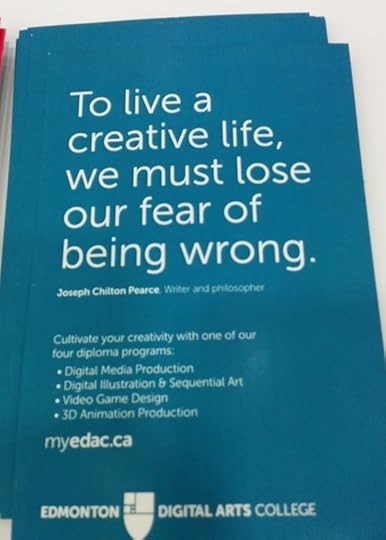
Food for thought in regards to getting your metaphoric hands dirty with your writing. Go ahead, be wrong!
Postcard taken from the EDAC (Edmonton Digital Arts College) booth during Eek! Fest 2015.
Draft Character Sheets
Keep character sheets simple and focus on key defining features for each character. The concept behind these sheets is to ensure that your characters stay within character. If they are to do anything drastic beyond their behavior, make note of it in the character sheet and develop a reason for the sudden switch in action during the story. For the sheets themselves, keep note of:
Character name
Their background/history
Their involvement with the plot
What their motive(s) is
What they love and hate
Notable physical features
Chapter Outlines
This is the most challenging aspect of the three steps, yet it is also the most important.
Chapter outlines should be key points that move the plot forward.
Each chapter outline should complement the story synopsis and elaborate it in further detail. Any sub-plots, change in scene, character development or action that progresses the story should be explained in each chapter outline.
The length of outlines will vary and can contain as much information as you see fit. Keep them in bullet point form and in short statements. Save the detailed descriptions for when writing the chapters. Treat the chapter outlines as a roadmap to move the story to the final conclusion. They don’t need to be perfect either. Remember, cranking out the first manuscript in a month is an achievement in its own right. You can come back and edit/revise the synopsis, character sheets, chapter outlines and manuscript afterwards.
Each of the three key points could have an article written about them individually. They all serve an important role for pre-planning your novel. The point for pre-planning in NaNoWriMo is to have a basic guide to help you when diving into the intensive month of writing.
Spend no more than an hour on each of the three points. Invest your time during NaNoWriMo.
The next blog post will expand on finding inspiration for the first week of NaNoWriMo. Facing the blank page can be daunting, they are your first words for your new novel. If you have any additional pre-planning techniques for writing, share your thoughts in the comments.
October 20, 2015
Breaking Into Writing Horror: Part 2 – Avoiding Clichés
When I decided to participate in 2014’s National Novel Writing Month (NaNoWriMo), it was the prime opportunity for me to try writing a brand new novel and a new writing style. NaNoWriMo forces writers to crank out 50,000 words in 30 days. Having to dedicate myself to writing at least 1667 words a day, I frantically typed out the first draft of my new novel, Seed Me, now in the editing phase.
After reading the first draft the month after, all I could do was shake my head.
The combination of fast typing and a tight deadline caused me to produce my worst work to date. Bravo! I gave myself a sarcastic pat on the back. Not to fear though. Now that I had a full manuscript completed, I had the ability to backtrack, cut, revise and add to the story.
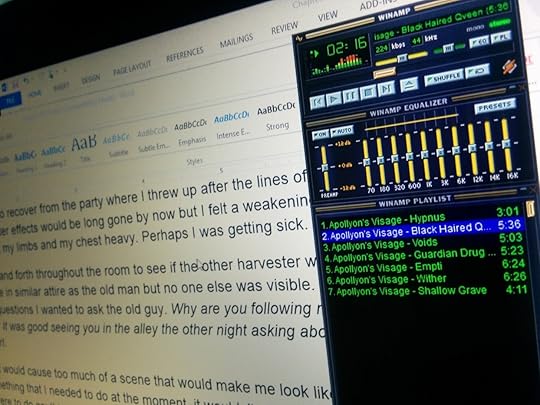 Revamping the manuscript while listening to Witch House music. Spooky stuff.
Revamping the manuscript while listening to Witch House music. Spooky stuff.
From December of 2014 to August of this year, I spent a lot of time cleaning up weak plot points, adding depth to one-dimensional characters and fixing grammatical/syntax errors. Inevitably, it led to deleting the second half of the story, replacing it with a new story arc and adding entirely new backstory about the antagonists.
During the past year, I researched how I could improve on the mess of a story that I created. My investigation led to learning the pros and cons of writing past tense, fact checking about Alberta to build a back story ( by visiting the Edmonton Archives) and avoiding horror clichés. I found a few great articles that helped me with my process.
 Photo Credit: edmonton.ca
Photo Credit: edmonton.ca
Darwin, E. (2014, February 17). Past and Present Tense: Which, Why, When and How [Blog post] Retrieved from www.emmadarwin.typepad.com
“Past Tense: Creating suspense is much easier, because we know there is a future to this story (because it’s being told from there), so the future is a mystery, not a blank, as in present tense. The narrator can even tell bits of it, or hint”, Emma Darwin advises.
Meikle, W. (2007, November 1). Horror Fiction – Ten Cliches to Avoid [Web] Retrieved from www.ezinearticles.com
“Splitting Up: Everybody knows that the monster is around somewhere, but someone says, “We’re off to explore that dark place. You go the other way and we’ll meet up later.’ “
Horror is littered with clichés and it is quite tough to avoid them when writing initial drafts. Try not to get caught up worrying about them.
Writers tend to write about what they know and I’ve watched plenty of horror movies. That’s why I reproduced these clichés in the first draft. But, as I brought up in the last post, “Write poorly and edit beautifully.” And that’s what I did.
The plot for Seed Me takes place in Alberta and features several plants as the antagonists, something that, I’ve found, is not exactly easy to do in horror. How frightening can plants be? Sure, you can make them supernatural, but then you start to lose the believability of the scenario and the fright is lost. As with my fantasy horror series, I turned to movies for inspiration. Cinema was, and is, the primary inspiration for my writing. I wanted to recreate the awe that movies give me into the stories I wrote.
Reading the article 5 Best Killer Plant Movies [2011, August 29], and watching these movies gave me some insight as to how murderous plants were tackled by other directors. It opened a door that I did not consider before – adding humour to the story. Horror isn’t always dark, serious and gloomy. Horror is meant for entertainment and sometimes, that includes some laughs.
Seed Me is well on its way to being completed.
A handful of beta readers have already previewed the pre-edited manuscript.
My editor and I are currently revising the plot and pushing it to be top notch. This story is still quite new and fresh to me. Right now, I have the difficult task of forming a quick summary without giving too much of the plot away. But for the time being, the plot will remain in a shroud of mystery for you interested parties.
October 15, 2015
Breaking Into Writing Horror: Part 1 – Where to Begin?
In 2011, I began pursuing my professional writing career by working on a fantasy horror series titled Mental Damnation. The original manuscript was written in high school and required a massive revamp of the story arch, characters and the overall writing style.
The plot needed to magnetize people and capture the reader’s attention to leave them wanting more, a common goal every author has.
Through many months of editing, the third person style that appeared in the first novel, Reality, had developed in the two novels that followed, Dream and Fusion and the fourth installment (yet to be titled) keeps this tense for consistency.
Working only on this series as my introduction into the writing industry turned out to be a major learning curve. Three years later, in 2014, I was still working on the same storyline. This brought me to a conclusion that it was time to broaden my abilities. As much as I enjoyed working on Mental Damnation and will continue to add to the series, it was time to branch off from the roots of my writing and try something new. I haven’t working on a new storyline since the high school manuscript.
The perfect time to embrace this growth happened in November, 2014, with the coming of NaNoWriMo (National Novel Writing Month). The objective of the writing month is to hammer out 50,000 words in 30 days. Tough, yet do-able. It was an opportunity for me to try out a new genre, new setting and writing tense.
Being a fan of horror in pop culture, I decided to tackle this genre. During October, I did a bit of pre-planning in preparation for November with basic story and chapter outlines, including character sheets of the three main characters. From the outline, the plot was very much a creature feature and was destined to evolve once I started writing. I also researched the work of H.P. Lovecraft and Clive Barker for inspiration and guidance into different horror-writing processes.
Two articles stood out from the rest. This is the first.
Jones, J. (2014, October 9). H.P. Lovecraft Gives Five Tips for Writing a Horror Story, or Any Piece of “Weird Fiction”
[Blog post] Retrieved from www.openculture.com
Lovecraft advises, “Write out the story—rapidly, fluently, and not too critically—following the second or narrative-order synopsis. Change incidents and plot whenever the developing process seems to suggest such change, never being bound by any previous design.”
Clive Barker also gave some insight.
Houghton, G. (1989). Writing Style
[Blog post} Retrieved from www.clivebarker.info
“I think one of the things I try to do is constantly try to do something different. If I constantly do something different I have succeeded. I don’t like to repeat myself because I feel once I’ve got the trick of doing something, I’m certain that the second time I try to do the same type of material it would not be as good” explains Barker.
These quotes expressed two key points that provided major clarification on how to proceed. I wasn’t sure how to start wring on a blank page because I had been involved with editing and revising an old manuscript for years.
The saying, “Write poorly and edit beautifully” came to mind during these revisions.
From encouraging words of horror greats, November rolled around and I begun to write the first draft of my new horror novel, Seed Me.
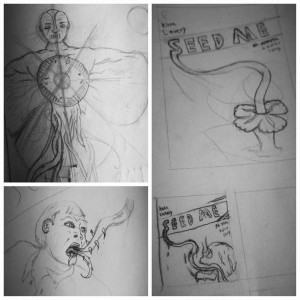
Novel Cover Thumbnail Sketches for Seed Me
I was well on my way to a new book, new characters and a completely different writing experience. Still rooted in horror, I was ready for the challenge of a new stand-alone novel. From this background research I was well equipped to dive deeper into writing horror.
Read Breaking Into Writing Horror: Part 2 – Avoiding Clichés
September 30, 2015
Damnation at the Edmonton Comic Expo
Marvel superheroes, internet trends and movie references, all mashed up in a buzzing weekend at the Edmonton Comic and Entertainment Expo. This was the second year I had a booth at this thrilling event. Each year proves itself to be unique and rewarding in its own. Despite not having a strong knowledge of more well-known areas of pop culture, I found it easy to mingle. I gained appreciation for visuals of the Expo’s booths and cosplay.
Day 0 – Pre-Setup
Thursday was an opportunity for vendors to set up early where I ran into a number of people I knew from 2014. This year, I took a new approach by deciding to downgrade to the Artist Alley. It was an experiment of a cost to margin ratio where previously I had a regular booth size.
Set up was quick and easy. Minus the over-analyzing of the booth to ensure symmetry among the display, a designer’s quirk (or OCD) kicking in.
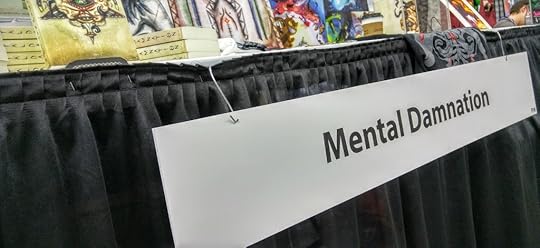
Day 1 – Catching Up and New Faces
The first day of the Expo, sweaty palms and second-guesses about the booth’s layout, I was eagerly anticipating meeting new people and seeing familiar faces. I manned the table on my own, which proved to be a success. I chatted with the nearby vendors in the area, caught up with folks from previous Expos and met like-minded, quirky/enthusiastic people who dropped by.
Through conversation, I met Matthew Gillies (his debut novel being The Electric Coma Dream), a fellow author of horror novels. Matthew, like myself, is also a graphic designer. Not exactly a regular mashup of trades. With this common background, we exchanged ideas and thoughts about the directions we have taken with our passion for writing.
 Day 2 – Costumes!
Day 2 – Costumes!Bright and early, the longest day of the Expo began with rushing out the door to join the SANE Clothing crew to partake in their photo shoot at Blues on Whyte. After laughs, poses and getting charged up on coffee, we all returned to the Expo.
I was thankful to have assistance at the table on the busiest day. After a short discussion, we rearranged the layout of the booth to have the books as the center of attention. No more second- guessing the layout.
The energy in the venue intensified up as the day progressed. The Expo was packed with people of all ages dressed up in their top-notch cosplay. My table helper and I were constantly informing the eager attendees about Mental Damnation and sharing in their experiences.
I reconnected with a fan of the book Dream who shared her artwork of what also happens to be my favourite scene in the series. It was a touching surprise that someone was willing to make artwork influenced from my work and share it with me. A moment of awe and reminded me as to why I enjoy writing – inspiring others to think and do something.
Even with help, the majority of the day was spent at the booth with a few breaks to grab food and say hi to a few other vendors. I took note of fun cosplay like Towelie from “South Park” and a handmade R2-D2 toque/onesie on a baby. The only downtime was the last hour, thanks to the costume contest, which gave us a moment to catch our breaths.
Day 3 – Coming to an End
On the final day at the Expo, it was rewarding to see the energy was still high, a constant over the weekend. It also hit me that it would take another year for the Expo to return. This was the first day I was able to get a good look around at the whole exhibit and see the new activities offered at the event. Sunday was slower than the Saturday, but I had an opportunity to say my goodbyes and call it a day.
Until Next Year
The Expo was a pan inspiration for me to bring my writing to similar events in various cities. New events are continuing to pop up all across Canada. Something else that caught my attention was friends that were vendors in previous years were just there as attendees this year. They had decided not to partake in the show and just appreciate the whole event, as opposed to being glued to their booths the whole time. This provided them a fresh perspective on the Expos. As a whole I have only been an attendee once at the Calgary Comic Expo. They it was good to get that perspective from past vendors
Future ideas to ponder on. The Expo once again, was well worth the time. I look forward to what next year will bring. It was astonishing to see the amount of people who I met last year returning to the Mental Damnation booth, asking what I had been doing since we last met. Seeing this has motivated me to get my fingers typing away for the finish the new book and aim to feature it at the 2016 Expo. Keep your eyes open and keep reading the blog for devopments on the new book!

Hello world!
I have started up my blog site! After years of having a landing page for the domain konnlavery.com, it has finally been converted into a place where my thoughts, adventures, inspirations, projects and more will be shared.
Blogging has been a foreign concept to me and I have been unaware as to how I should approach it or what to even write about. Through research and informative advice I’ve decided to take a stab at it. Look forward to sharing and starting up conversation.
The featured image for this post has been made a dinosaur, just because I’m a fan. No actual reference.
Posts from konnlavery.com
- Konn Lavery's profile
- 156 followers




